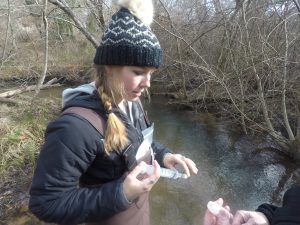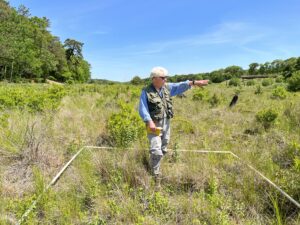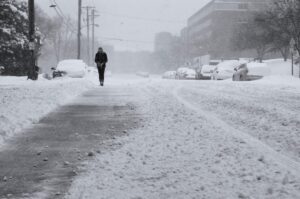This town on the Cape is a hub for climate scientists. Under Trump, its local economy is shaking.
The small community on the upper Cape has been a company town for environmental scientists for over a century.

An unease has settled over this small-town community of scientists lately like the fog that crept across the upper Cape on a recent March morning.
It’s difficult to see around the bend: Will the scientists have a job next month? Will their life’s work be halted? Will their colleagues flee abroad, seeking funds and political support for their research?
“Science in Woods Hole is most definitely under threat,” said Max Holmes, president and CEO of Woodwell Climate Research Center.
“We don’t know what the future holds, but we’re not going to just sit back and wait,” Holmes said. “We’re going to use our voice.”
Continue reading on The Boston Globe.
How rolling back EPA regulations could impact New England air and water

Researchers and advocates in New England say the federal government’s plans to reconsider environmental rules could have long-lasting effects on public health, air pollution and ecosystems in Massachusetts and across the region.
The Environmental Protection Agency this week announced a long list of regulations it expects to review including those that limit factory pollution, vehicle emissions and wastewater from coal-fired power plants.
Woods Hole researchers rally to support the sciences

Hundreds of people gathered at Waterfront Park in Woods Hole Friday as part of the Stand Up for Science rallies held around the world in response to the Trump administration’s federal funding cuts in scientific research and diversity equity and inclusion initiatives.
Jim Newman, one of the organizers of the event and an engineer who has worked in oceanography, said it is important for the Woods Hole community to take part because of how integral scientific institutions are to the village.
“We heard about this national effort and said we got to do something in Woods Hole. How could we not, given who we are?” Mr. Newman said. “The world of science is under attack. There are drastic cuts being threatened…It’s very local because science is a huge part of Woods Hole.”
Continue reading on Vineyard Gazette.
‘Save NOAA.’ Science rally on Cape Cod draws crowd of supporters PHOTOS

Demonstrators cheer on Congressman Bill Keating as he speaks at Waterfront Park in Woods Hole during a noontime science rally as part of a nationwide protest of spending cuts to science programs. Photo Taken on March 7,2025
See the photos on Cape Cod Times.
Yes, New England really was colder when you were a kid. Climate change makes snowy winters feel like a treat.
Baby Boomers grew up with two more weeks of frozen lakes than Gen Z is living with now.

Finally. We watched snowflakes glimmer in the light of street lamps. Kids played pick-up hockey on frozen ponds. And skiers relished in the abundant snow cover — a booming ski season was back.
After years of warm winters that limited snow sports and often left the ground muddy instead of blanketed by white, New Englanders this year welcomed back a winter season that felt, well, cold.
This more classic New England winter is thanks to a weak La Niña weather pattern that tends to draw in more cold air and help whip up storms. Even so, this winter doesn’t come close to the hallmark bitter cold winters of Boston: Temperatures trended below average but were generally well within what’s considered normal. And the snowfall in Boston was actually below average between December and late February.
Continue reading on The Boston Globe.
Ecologist Neill honored with outstanding public service award

In his office at the Woodwell Climate Research Center, Christopher Neill’s framed Outstanding Public Service award from the Massachusetts Association of Conservation Commissions sat on a small table. When asked about his many accomplishments and accolades, Dr. Neill preferred to speak of the good work done by the organizations he works and volunteers with. He spoke highly of his peers at Woodwell and all the scientific groups he has collaborated with.
Dr. Neill is an environmental ecologist, studying natural ecosystems and the organisms that live in them.
Read more on The Falmouth Enterprise.
The polar vortex is acting weird and the US is paying the price this winter

It’s really, really cold again — as the US shivers through at least the eighth blast of air from the Arctic this winter.
Winter, which is warming faster than any other season for much of the US, seems to be making a comeback for the first time in years; this January was the coldest in the Lower 48 since 1988.
But the US is an outlier, and so is this winter. January was the warmest on record for the globe and, in a vast expanse of global warmth, the US sticks out like a cold, sore thumb.
Update: How’s U.S. winter weather changing in a warming world?
Cold extremes are indeed waning over most of the midlatitude Northern Hemisphere, but a decade-plus debate on the Arctic’s role continues.

When a full-fledged snowstorm descended on the U.S. Gulf Coast in mid-January 2025, followed by a night of unprecedented cold across some bayous and beaches (see Part I of this two-part post), it did more than turn New Orleans and Mobile into winter wonderlands. It reignited a topic that’s cropped up again and again across science and media landscapes since the early 2010s: Is a warming Arctic affecting winter extremes over North America and Eurasia? And if so, how?
Read more on Yale Climate Connections.



